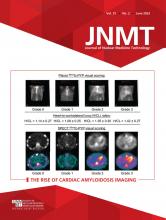Visual Abstract
Abstract
Our objectives were to establish normative quantitative values for dacryoscintigraphy in an older population and to evaluate the effect of lid massage. Methods: We conducted a prospective study of 44 eyes of 22 participants aged between 54–90 y that had no symptoms of epiphora and no clinical tear film instability, lid abnormality, lacrimal system impairment, or patent lacrimal duct on syringing. Dacryoscintigraphy was performed and interpreted by a single nuclear medicine physician. The scan protocol involved instillation of 99mTc-pertechnetate in each eye, with a 45-min scan performed with 1-min frames. Lid massage and a sinus clearing maneuver were then performed, followed by a further 45 min of scanning. Results: The mean age of the 22 participants was 71.9 y. Quantitative analysis by half-clearance time (HCT) demonstrated a median presac HCT of 25.5 ± 15.0 min and a whole-eye HCT of 40.0 ± 19.5 min. There was no association between age or sex and HCT. Qualitatively, 29 of 44 eyes (66%) appeared to have at least 1 region of delayed clearance, with improvement noted in 23 after lid massage (79%). Conclusion: We report the quantitative values for dacryoscintigraphy in an asymptomatic older population who had normal findings on lacrimal examination. A high rate of delay in radiotracer transit on qualitative examination suggesting a low specificity. The false-positive rate was significantly improved with the novel approach of adding lid massage, and the significance of this finding merits further research.
Footnotes
Published online May 16, 2023.








